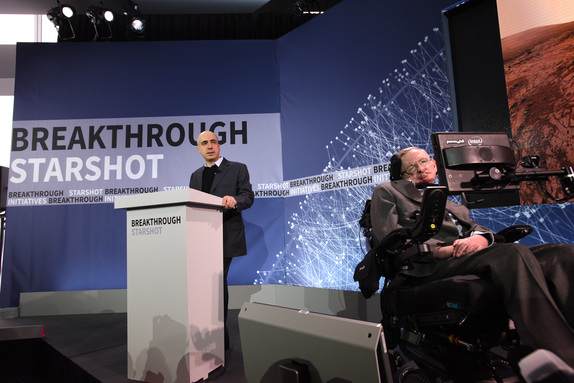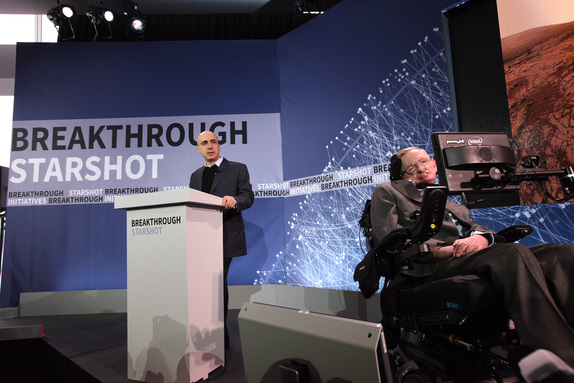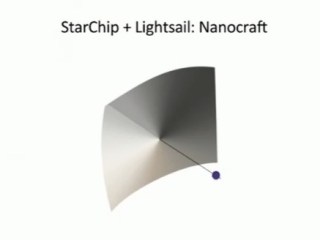
(via Getty Images)
When you hear, “Stephen Hawking is at a live announcement about space travel,” you tend to listen up. You also tend not to be disappointed, as today saw the announcement of Breakthrough Starshot, an effort to build proof-of-concept space probes based on a culmination of technological advancements that will allow us to explore interstellar destinations within our own lifetime—specifically Alpha Centauri, but other places, as well.
The announcement (replay of the livestream here, which is worth it just for Hawking’s joke about human intelligence) featured not only Stephen Hawking himself and Yuri Milner but also included a panel with theoretical physicist Freeman Dyson; Ann Druyan, original Cosmos co-writer and creator/writer/producer on Cosmos: A Spacetime Odyssey; Harvard professor and Department of Astronomy chair Avi Loeb; NASA astronaut Mae Jemison; and astrophysicist and retired NASA Ames Research Center director Pete Worden. Why was Alpha Centauri such a big topic during the event? The three-star system is our solar system’s nearest neighbor in space at only 4.37 light years (25 trillion miles) away. While even that relatively short (in terms of outer space) distance would still take impractically long to cross with traditional spaceflight methods, Breakthrough Starshot’s work-in-progress space probes would be able to make it there in only about 20 years by accelerating up to about 1/5 the speed of light.
Traditional propulsion methods require an impractically, laughably huge amount of fuel to accomplish the same thing, and technologies like fusion are far from a near-future solution. Leaving the propulsion system back on Earth is a far more practical, and as Milner explained, they’d accomplish that feat by making use of technological advances in three areas: miniaturization of electrical components, thinner and lighter materials for use in a light sail, and laser technology. The Starshot probes will be “nanocrafts,” basically a space probe on a microchip (StarChip) with a giant sail propelled by laser beams from Earth (no matter how much “shooting lasers at spaceships” sounds like a supervillain plan):
The Planetary Society’s LightSail spacecraft are already making use of the energy of photons for their propulsion (and NASA’s Kepler observatory is even using it for balance), but this would be an unprecedented use of the technology—or any technology. Even if humans still couldn’t go to faraway destinations in space, the ability to quickly (and affordably, at “the cost of an iPhone,” according to Milner) send out probes to search the stars and planets beyond our current reach would bring in an unprecedented amount of new data about our Universe.
It’s not just those interstellar locations that the nanocrafts will revolutionize, though. Inside our very own solar system, multi-year space exploration projects could be cut down to mere days, and Avi Loeb pointed out that the relative inexpensiveness of the probes would allow us to send them to dangerous places we’d never dream of sending multi-million dollar space robots. We’d be able to easily get up-close and personal data from some of the most dangerous phenomena out there.
And there are plenty of phenomena out there worth exploring, Freeman Dyson reminded everyone. He cautioned that thinking of Alpha Centauri as an end-game undersold the enormity of what the nanocraft could achieve. Dyson explained that in between the stars and the planets are countless smaller objects and bits of matter that the probes would inevitably pass through on their journey to more visible destinations, and they could unlock whole worlds of exploration of things too tiny and distant for us to even notice from Earth. He’d rather we focus on the journey more than the destination and the idea that this can be a sustainable, ongoing research effort into literally everything in existence.
The entire thing was an exciting presentation, made even more stirring by the idea that this technology could be ready and working within our own lifetimes using foreseeable technological advancements, dawning a new age of space exploration and scientific data. Loeb said that while they’re still working on technical hurdles (getting the laser array set up under the proper conditions, properly shielding the nanocraft from outside forces in space, and so on), none of them appear to be insurmountable hurdles but rather reasonably solvable engineering problems. To that end, the Starshot project aims to be entirely transparent, and experts and the public alike will be able to view details about these obstacles on http://www.breakthroughinitiative.org/.
—The Mary Sue has a strict comment policy that forbids, but is not limited to, personal insults toward anyone, hate speech, and trolling.—
Follow The Mary Sue on Twitter, Facebook, Tumblr, Pinterest, & Google+.










Published: Apr 12, 2016 03:02 pm